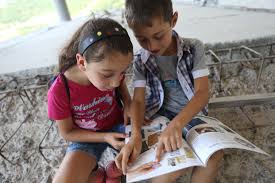No-lose Method
This is a democratic approach that results in caregivers and children resolving conflict in a manner in which all parties are satisfied with the solution.
How to use this method:
- Define: All parties communicate their perspectives of the “problem”.
- Brainstorm Solutions: All parties list all possible solutions to resolve the issue.
- Assess Solutions: All parties decide and discuss how they feel about all of the solutions.
- Best Solution: All parties decide upon and agree to implement the best solution.
- Plan in Action: All parties put the best solution into practice.
- Follow-Up: Adult(s) proactively discuss the problem and solution with the child(ren) to revisit the situation[1].
Example

- Define: The “problem” is that siblings are fighting over a book.
- Brainstorm Solutions: The children can take turns reading the book; each child can read a different book; both children can read with each other at the same time with that book; a parent can remove the book so both children need to find different books.
- Assess Solutions: Both children want to read the book together.
- Best Solution: The children and parent agree that the children will read the book together as long as the children do not fight. If they fight while reading the book, the parent will remove the book and both children will need to take a break.
- Plan in Action: The children read the book together and do not fight.
- Follow-Up: Later that same day, the parent asks if they both enjoyed reading that book together. Both children agreed it was an enjoyable time. The parent praised them for not fighting and for solving the issue.
Key Takeaways
- This method is used to resolve conflict where every party involved discusses their perspective on the problem and possible solutions.
- A solution that satisfies all parties is decided and agreed upon.
- Heath, P. (2013). Parent-child relations: Context, research, and application (3rd Ed.). Pearson. ↵

